23rd February 2008 : A Gruesome (yet fascinating) Tale
 Saturday, February 23, 2008 at 10:02PM
Saturday, February 23, 2008 at 10:02PM Can anyone guess what this is?
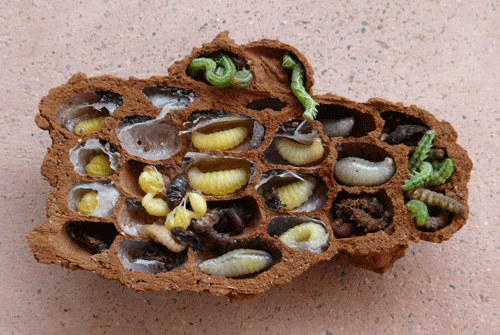
Believe it or not, this is a hornet’s nest - yes, that's the insect that looks and stings like a wasp.
Some hornets had built this mud nest in our solar power control room (which has to remain completely free of any dust or dirt), so sadly Ian had to break the nest off the wall. We were quite fascinated by what was revealed within, when looking at the nest from the back, where it would have been stuck to the wall.
The tale of the breeding hornet is quite macabre so if you’re squeamish, stop reading now…
The parent hornets collect caterpillars (seen here in green), bring them back to their mud nest and place them in a compartment. While the caterpillars are still alive, the female hornets lay an egg inside them. When the eggs hatch, the larvae (the plump white things in the photo) eat their way out of the caterpillars, a ready-made fresh food source, killing them in the process. If you look closely, you can see some dried up remains of the dead caterpillars, still in the nest beside the fat larvae and alongside the brand new hornets, which you can see pupating and already taking the insect’s adult form.
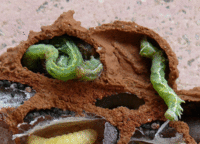
Close-up of the doomed caterpillars, each of which has had a hornet's egg laid inside it, which will hatch and kill it.
Click any image to enlarge

Unattractive in the extreme: fat, squidgy hornet larvae
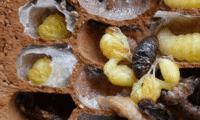
Starting to take on the adult form: hornet pupae developing
Gruesome it may be, but incredible nonetheless that even a simple insect like a hornet could have such a complex, ultimately sophisticated life cycle, providing fresh food and housing for its young until they too are ready to embark into the world, seek out some hapless caterpillars, and start the cycle all over again. It makes you ask yourself, is every single creature (and indeed plant) in nature equally complex, with an equally fascinating story to tell, if only you take the time to look closely enough?
Sadly for our voracious hornet nestlings, they never had the chance to spread their wings, for their parents had chosen the wrong place to nest, in a place where we couldn’t possibly leave them be without jeopardizing our entire electrical power system.
But do not fear: our developing hornets did not go to waste. We laid the nest on the bird table, thinking that the starlings would enjoy this feast, so high in protein and fat.
As it happened, the birds didn’t get a look in, for the first on the scene was the male Rainbow Skink who has made our balcony his home. (Incidentally, another skink family has taken up residence under the fridge in the kitchen.)
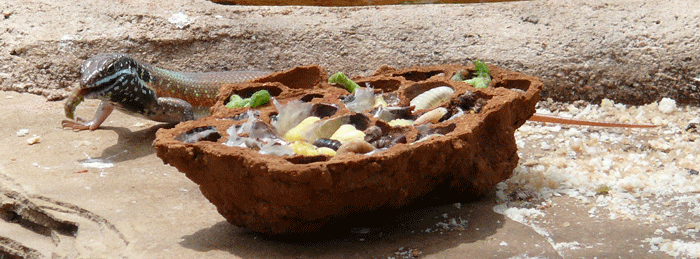
This sharp-eyed skink was not going to let this windfall meal pass him by, and he systematically devoured the contents of the hornets’ nest - larvae, caterpillars, pupae and all - until it was a completely empty shell. I don’t think even one tiny morsel was left for the birds…
Speaking of industrious insects, the other day I saw this band of ants moving their enormous clutch of eggs from one place to the other, and in the process crossing those equally fascinating plants which I, for want of knowing their proper name, call my Tsavo Succulent Clones (see my earlier description of these amazing plants in my diary entry for 23rd October 2007). We were also visited by a rather handsome Praying Mantis who spent all day sitting on the canvas back of one of our chairs on the balcony...I only mention him in passing here, because I thought he deserved a picture and this seems as good a spot as any to place him...
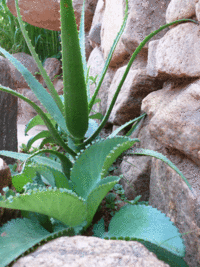
A huddle of ants move their thousand-strong clutch of eggs across our balcony flowerbed
Click any image to enlarge it
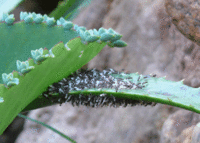
Ants moving eggs in close-up...
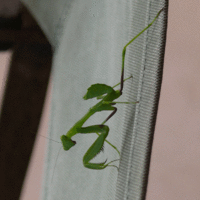
Our perfectly poised Praying Mantis
View more photos of Insects, Snakes and other Creepy-Crawlies...
Want to see some images of adult hornets? Check these out:
Hornet on white flowers - image one
Hornet on white flowers - image two
Hornet on white flowers - front view





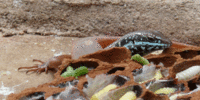
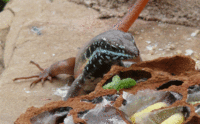
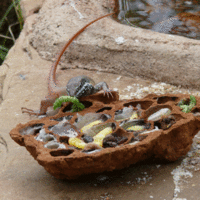
Reader Comments (12)
Absolutely fascinating and not at all yucky. Nature is incredible.
Tanya, I feel sorry for the hornets, but the skink was lucky. Do you have a photo of a grown up hornet? Kenyan wasps don’t look like European wasps at all and I’ve been bitten once without any provocation at all and another time with just very slight provocation. In Europe I’ve only been bitten once by a wasp and that was when I happened to step on one.
Praying mantis are like little extraterrestrials when they turn their head to look at you. It would be fascinating if life was found on other planets, but there are so many weird and wonderful creatures on this planet that I know almost nothing about, so there’s really not any reason to feel lonely. Do you know if there’re any books about East African insects?
Being eaten alive IS gruesome, but I didn’t stop reading.
Nice to see you here again, Suzanne...
and hi Nyamera...indeed I wish I could find a good book about Kenyan insects - I haven't found one yet so I'm hopeless at identifying them - I really want to learn...I felt sorry for the caterpillars AND the hornets...but as you say, at least the skink had a good meal (not that he's exactly starving with all the bugs around here!). I'm going to look and see if I have any adult hornet photos and I'll get back to you here - we have lots of different types (and if I had an insect book, I'd be able to tell you something about them and what they're all called)...watch this space!
Hello again, Nyamera...found some images buried in my photo libraries here...check out:
Hornet on white flowers - image one
Hornet on white flowers - image two
BTW, if you want to look for pictures of any other creatures or plants, you can always use the Search Facility in the right hand menu here...it should work!
Here's another photo from a different angle: Hornet Picture
Thanks Tanya! Those are exactly the kind of insects that love to sting me! A European hornet looks like this, like a big wasp. http://en.wikipedia.org/wiki/European_hornet That’s why I’m so confused when people call your hornets “wasps”.
To me, your European Hornet looks almost bee-like (this is getting confusing!)....so I started researching this a bit further...
A hornet is (apparently) merely a type of wasp - there are hundreds of different types of wasp in the world, of varying sizes and aggressiveness. Hornets tend to be among the larger wasps, I believe.
Wikipedia has a good comparison of common bees and wasps (not including my hornets though): http://en.wikipedia.org/wiki/Characteristics_of_common_wasps_and_bees
and also an article on hornets (which apparently contains some elements which need verifying, but has some interesting info nonetheless): http://en.wikipedia.org/wiki/Hornet
You'll be delighted to know that bees can only sting you once (then they die), while a wasp/hornet can withdraw its sting and come after you again! And I do sympathize, I have also been stung by hornets - without any obvious provocation.
Wow! This is fascinating!
Simply amazing photographs...Do you mind if I ask what camera you use?
I added you in my RSS Reader..Can't wait to see more!
See you later!
Brad
Hi Brad, Hi Sandpiper -
Thanks for stopping by, and for the compliments.
I use a Panasonic Lumix (can't remember the exact model just now)...it's got a Leica lens (35 - 420mm equivalent) which is really a fantastic lens - the clarity is superb. The downside is that this is not an SLR camera, so there is a delay when you press the trigger - fine when you're photographing flowers but FRUSTRATING when you're trying to capture wildlife action...often you miss the critical moment, because you have to predict things, and then click the shutter a second in advance...I'm saving up for a DSLR so hopefully that will improve things on that front...
See you again soon -
Tanya
Health care products on our website side of things I hope my dear friends to choose our products so your body to be healthy the mood will be good welcome to buy
African superman
Chaojimengnan
V-max
Jiubianli Male Sexual Products
Dragon Power
EXTENZE
Viagra
Gold Cheetah
Super hard
hacker
kangroo sperm
great man
love conquer
Play boy
Prosolution
manking
Strff night
america bull
Traditional Chinese Medicine Vigra
Herbal Viagra
Vim 25
Herb viagra pills
Golden Root
Super dragon 6000
Super Bull
IMPOTENCE
Top Strong Man
Female Libido Coffee
Yingdaodi
one night eight times
nanrenshengbao
Da buwan
Tiger columbia(Yohimbine)
WUYESHEN
African Black ant
Mars for man
VIQ
Green Viagra
LaoPiaoKe Harbal Sex Medicine
Golden viagra
vmax
vastim
Bedroom bully
Cavaliers
Delay king
GOLDEN HERACLES
MAX STAMINA
natural
STIFFY
super desire
Super Hard 2
super hard 1
TOP MAN
V8
WARRIOR
MIAMAX
VIP increase pills
two days diet
7 Day Herbial Slim
8 Slimming Effects
Fruit Body
French Coffee
Zi ranshou
slimming
Leptin Green Coffee
Lida
Loss weight coffee
Maise 1+1 Nutrition Slim Pill
Impeous Man
Meizitang
plant fruit
Super Slim Pomegranate Weight Loss Capsule
sunshine beauty
Slimming toxin
MAXMAN 2
slimming coffee
super slim
Slimming Essence
Basha Qiyi Slimming
Likeshou
The toxin-discharged tea
Jimpness Beauty Fat Weight Loss
Slim Express Tea
Apple Lighting Silm
paiyouguo tea
Paiyouguo Slimming
paiyoushoufu
3 Days Diet
shoufsy
Fruit Beauty Slimming
One day diet slimming capsule
Botanical Slimming
Japan Weight Loss
Weight lose multidimensional
L-Carnitine
P57 Hoodia
Quick Show Slimming Tea
YuDa Brand Pilatory Quick
YUDA hair
Black Gold
YUDY
8.H.R.ENERGY sex medicine
Black Ant
Super Man
Tiger King
Street Overlord
South Africa Viagra Element
Snow Leopard
Satibo Capsule
powerful Viagra
Plant Strong Genital Renewable
Cialis
Cialis 20mg
Erection And Penis Enlarger
Furunbao_Capsule
Golden Viagra
Icerex
India Black Edition
Kamagra 100mg
Kamagra Oral Jelly
Leopara Dint
Levitra
Levitra Capsule 2
Libigrow
Lrvitra Capsule
Man Up
Maxman2000mg
MaxmanIII
Vegetal Vigia
Rock Hard
Samurai-x
Viapro
Vigour300mg
Vigrx Capsule
Vigrx Plus
Vigrx Zengdawan
Wodibo Capsule
Health slimming Coffee
Magic Slim
Super Slim
Shoufutitun
Those look like what we around here call 'mud daubers' - the mud daubers around here catch spiders to put in for their larvae to eat, not caterpillars. While I've heard that mud daubers CAN sting you, I've never been stung by one. Evidently different mud wasps catch different things to stock the larder. :)